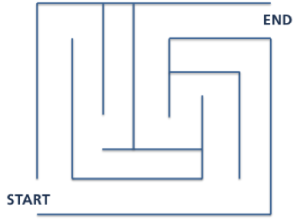In working with 100 plus entrepreneurs at my accelerator, my pre-accelerator, in my MBA class and elsewhere, I constantly see entrepreneurs looking forward into the unknown future, but few looking backward. Not backward into the past, but backward from their ultimate goal.
This is most easily explained by stepping back to pre-school, back to the time when you first learned about mazes:

In this maze, the path from START to END is not obvious. There are choices to be made, and potentially dead ends to backtrack from. However, if you work the maze from END to START, the path is quite obvious.
A similar technique can often be done when planning startups. Rather than peer into the unseen future, put your mind into the future, years from now when your startup has succeeded. What does that END state look like?
Looking backwards from the END, what milestone must have been reached to reach the END? Let’s call that the END-1 state. Then looking back from END-1, what must goal must have been reached to get that far? That is END-2. Continue stepping back in time until you reach your current state, i.e. your START state, or a milestone obviously reachable from the START.
No business plan survives contact with customers Tweet This Quote
I learned this technique when working with the Chasm Group, a business planning consultancy set up by Geoffrey Moore, famous for authoring Crossing the Chasm. We hired them to help us plan Ground Truth, my fifth startup. At the time, the plan was to be the market leader for mobile-centric market research. To disrupt comScore and Nielsen, who at the time were focused on online usage.
Working backwards, our ideal END state was to be the clear market leader, with 80-plus percent market share. To achieve that goal, we clearly had at some point earlier passed the tipping point of 50 percent market share (END-1). To reach that 50 percent milestone, we proposed we needed half of the major advertisers and half of the major publishers as customers (END-2). That would then ensure that most of the dollars flowing in the market (assuming the dollars in mobile would be based on advertising, like every other media) would be based on our reports. Finally, to get us on the path toward the END-2 state, we surmised we needed 10 major advertisers and 5 major publishers (END-3), who would quote the metrics in our reports, and with that others would follow. At the time, we had nothing more than a working prototype and a few mobile operators enjoying our market research (START).
Where is your startup headed? How can you quickly and efficiently reach your goals? Take a moment to work backwards Tweet This Quote
From this backwards plan, we then worked out timelines on how fast we would have to meet these goals, given the amount of money we had raised ($2 million at the time) and how quickly sales would have to grow to meet the expectations of our venture capitalist investors.
Prior to this exercise, looking forward, all we could see what a list of 100 top publishers and to 100 advertisers, and a suspicion that the more we signed the better. Beyond the normal fact that more customers and more revenues is generally better, the forward view didn’t let us see how to “win” the whole market.
Do note that while this is a useful example of the technique, no business plan survives contact with customers, and this plan was one acquisition, one merger, and one pivot ago, with Ground Truth now part of Zettics, doing quite well in a slightly different market.
Where is your startup headed? How can you quickly and efficiently reach your goals? Take a moment to work backwards, and see if that makes the future a bit clearer.
This originally appeared on Luni’s blog.



